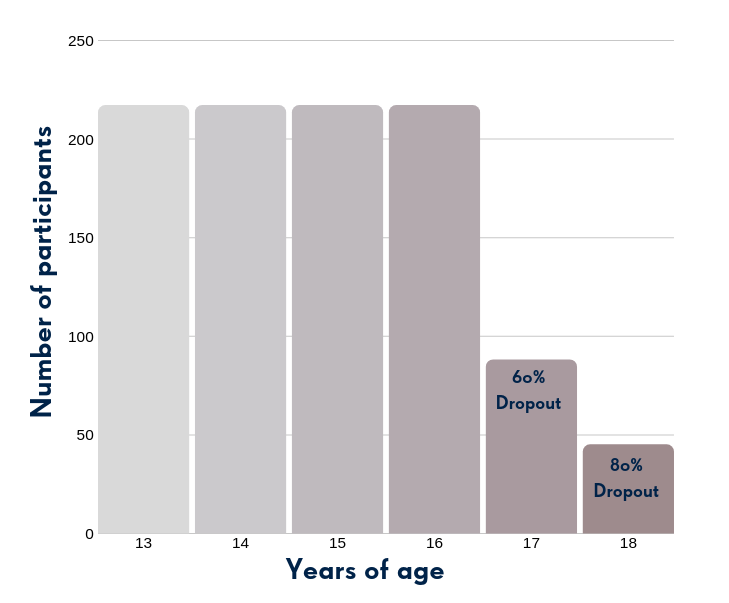Dropout rates across all sports is a worldwide issue, particularly in children. According to Weiss and Ambrose (cited in Monteiro et al., 2017) there is a decreasing number of youth aged 14 – 17 involved in sports when compared with those aged 5 – 13, and they estimate that more than one-third of all participants aged 10 – 17 drop out of sports practice annually.
A systematic review (Monteiro et al., 2017) looking at the main reasons why swimmers drop out include:
- Conflicts with their trainers;
- Other things to do;
- Competence improvements’ failure;
- Parents, couples or trainers’ pressure;
- Lack of enjoyment;
- Boredom.
Swimming Australia has recently made several positive changes to their competition framework as a solution to improve on their retention of swimmers at a National Level (Swimming Australia, 2018).
Three key changes include:
- Removing the overall team point scores from the Age National Championships;
- Removing the bottom age group bands (Boys 12 & 13 Years, and Girls 12 Years) and top age group bands (Girls 17 & 18 Years, and Boys 18 Years) from the Age National Championships; and
- Adding these older age bands to the Australian Open Championships (Swimming Australia, 2018).
In Swimming Australia’s study of 6014 swimmers who competed at the Age National Championships from 2000-2014, they found that out of all the swimmers who competed as a 13-year-old, only 50-60% participated at the event the following year (Swimming Australia, 2018).
To get a better idea of the dropout rates at the Age Nationals, I analysed the last group of female athletes who competed at this event as a 13-year-old in 2013, right through to their last year competing as an 18-year-old in 2018. From 2013-2016 there was a total of 217 female swimmers who competed in this age band, and in 2017 there were only 88 of these swimmers competing as 17-year-olds (dropout rate of 60%) and in 2018 there were 45 swimmers competing as 18-year-olds (dropout rate of 80%).
A study of the number of girls swimming competitively between 2013 – 2018

Swimming Australia in collaboration with the Australian Institute of Sport (AIS) have developed The Australian Swimming Framework (Swimming Australia, n.d.) which describes the Swimming Australia athlete pathway, detailing athlete characteristics and how they develop at each stage.
Most school aged club level swimmers (aged between 12-14 years) who are competing at a State Championship level would be classified as a Talent 1 or Talent 2 athlete. Under these guidelines the recommended number of competitions per year for these swimmers is 6-8 (Talent 1) or 8-10 (Talent 2), including school swim meets. In addition, it is recommended that these swimmers have 10-14 weeks of recovery and regeneration per season. Most swimmers that I see involved in other club programs have swum at 6 swim meets in Term 1 alone this year and would train for at least 48 weeks per year. I believe that both factors play a role in swimmers leaving the sport due to mental and physical burnout.
Swimming Australia’s changes won’t be enough to make a positive impact, and it is now up to swimming clubs to adapt and adjust their training and competition plans, as there is currently far too much talent leaving the sport at an age well before swimmers reach their peak.
At Artemis Aquatics, swim squad training focuses on skill development and fun in the foundation and early talent years. Gone are the days of gruelling aerobic training programs with swimmers training 7 x 2-hour sessions covering 35km per week. We believe that there is little to be gained from placing too much pressure on a superstar 11-13-year-old who leaves the sport at the age of 14 due to the excessive demands and pressure placed upon them.
Coaches at Artemis Aquatics focus on the long-term athletic development of each swimmer. From our Learn to Swim program right through to our competitive swim Squads, we provide them with the best chance to reach their full potential, keeping them involved in the sport for longer.
JOIN NOW
References
Monteiro, D., Cid, L., Marinho, D. A., Moutao, J., Vitorino, A., & Bento, T. (2017). Determinants and Reasons for Dropout in Swimming -Systematic Review. Sports (Basel), 5(3). doi:10.3390/sports5030050
Swimming Australia (2018). Swimming Australia Launches New Competition Age Bands for Long Term Athlete Development. Retrieved from: https://www.swimming.org.au/news-articles/swimming-australia-launches-new-competition-age-bands-long-term-athlete-development
Swimming Australia (n.d.). Swimming Australia Framework. Retrieved from: https://www.swimming.org.au/community-1/australian-swimming-framework